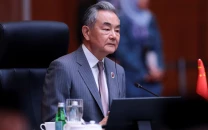Brewing conflict in Indo-Pacific
The standoff between Iran and the US hasn’t unequivocally thawed

The writer is a private professional and writes on geopolitical issues and regional conflicts
US Army Secretary Ryan McCarthy said the Pentagon for the first time would deploy its Security Force Assistance Brigades (SFABs) in the Indo-Pacific to “neutralise all the investments China and Russia have made”.
Deployment of multi-domain task forces — with a focus on the realms of intelligence, information, cyber, electronic warfare and space battalion (I2CEWS) — will be carried out within the next two fiscal years and would aim to bolster alliances with regional partners.
The US military has long sought to send the SFABs to Africa and East Asia but until now the advise-and-assist units have only been placed in Afghanistan where it has seriously struggled to find enough experienced troops to do the job and botched to develop the combat capabilities of the Afghan forces.
It is thus pretty skeptical how American specialised crews would evolve a new paradigm to “punch a hole” in the enemy defences or even persuade US allies to confront formidable Chinese and Russian militaries.
Though the Secretary contended that China was “militarising the global commons” through the Straits of Malacca to justify US military presence in the Pacific, he discounted the verity that the deployments overseas of permanent US military and civilian personnel had exceeded 228,000 as of September 30, 2019.
Russian Foreign Finister Sergey Lavrov on Tuesday dismissed the US concept of “free and open Indo-Pacific (FIOP) Region” as “destructive” with goals to divide the regional countries into “interest groups”.
The Pacific is the US Department of Defense’s priority theater where it pledges to extend its commitment of regional stability and prosperity through the “pursuit of preparedness, partnerships, and the promotion of a networked region”.
Immediately after it revived peace talks with the Taliban, US Defense Secretary Mark Esper in December said he wanted to reduce US military presence in Afghanistan to pay greater concentration on the strategic competition with China.
Fear of turbulence in Afghanistan was the reason why just hours before the strikes, Secretary Mike Pompeo hammered Tehran for its indisposition to join the Afghan peace process and accused it for maintaining a relationship with the Taliban and other militant factions.
While China, Russia and Pakistan were exerting deep efforts to decode a political solution in Afghanistan to end the US impasse in cemetery of superpowers, Washington was conspiring to relocate its troops from Kabul to the Indo-Pacific to seek a face-off vis-à-vis Beijing and Moscow.
The US sees a partnership with India as a vital gadget to its Indo-Pacific vision. Though Indian Prime Minister Narendra Modi cleared up in June 2018 during Shangri-La Dialogue that New Delhi does not see Indo-Pacific region as a strategy or “Quad” — an alliance comprising Australia, India, Japan and the US, a threat to China — the relocation of US troops from Afghanistan to the Indo-Pacific-peddled Washington has aligned New Delhi to alter its strategy.
Indian Foreign Minister S Jaishankar’s remarks last month about “open and free” Indo-Pacific described a changed New Delhi stance in the region. The Indo-US wired strategic partnership is fated to elicit tensions for China, after Washington would alienate Islamabad having withdrawn from Kabul. The US in return is likely to aid India to encircle Pakistan.
Even as Islamabad could seek profounder assurances from Washington that it won’t echo the history of ditching Pakistan once its objectives are met in Afghanistan — China and Pakistan would be closely monitoring the evolving developments and ratchet up military and strategic engagements to protect each other’s interests.
Published in The Express Tribune, February 3rd, 2020.
Like Opinion & Editorial on Facebook, follow @ETOpEd on Twitter to receive all updates on all our daily pieces.
















COMMENTS
Comments are moderated and generally will be posted if they are on-topic and not abusive.
For more information, please see our Comments FAQ